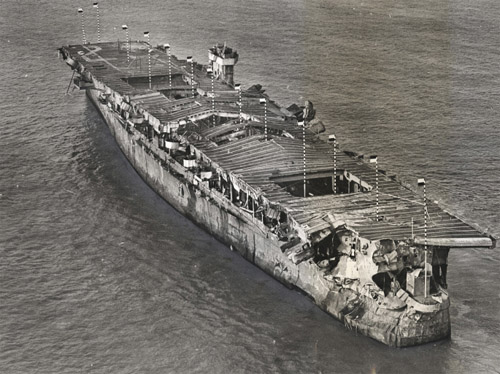Hundreds of barrels of radioactive waste are found off the US coast
Some researchers are concerned about the possibility that hundreds of radioactive waste can be found in the newly discovered ocean carrier, about 50 km from San Francisco, USA.
Detection of radioactive waste off the US coast
The expedition of the National Oceanic and Atmospheric Administration (NOAA) recently discovered the USS Independence at a depth of more than 790 meters above sea level off the Farallon Islands, San Francisco. This is the area where the federal government dropped nearly 48,000 barrels of low-level radioactive waste into the sea during the period 1946 - 1970.
USS Independence CVL-22 operated in the Pacific during World War II between 1943 and 1945. In 1946, it became one of 90 ships participating in the Bikini Atoll atomic bomb tests. Destroyed heavily, the ship later became a nuclear demolition lab parked at the Naval Hunters Point shipyard in San Francisco. The US Navy put up some radioactive waste barrels and pulled them into the sea, sinking with two torpedo explosives.

Some scientists are concerned about the amount of radioactive waste on the USS Independence.(Photo: Reuters)
The discovery of the current USS Independence poses health and environmental hazards to living creatures around the Farallon Islands radioactive waste, home to many marine species.
James Delgado, NOAA official, who spent the past two years researching shipwrecks around the Gulf of the Farallones National Marine Sanctuary, suspecting hundreds of radioactive waste can remain in ship Independence. However, he did not think they were harmful to the environment or human health. These waste bins are filled with concrete and sealed in the engine of the ship and the control rooms, where there are thick steel walls, he said.
The ocean also acts as a natural buffer for radioactive material , says Kai Vetter, a nuclear professor at Kai Vetter University, who supports research. Vetter stressed that the sites were infected on a small scale, so it did not affect the food chain on a larger scale.
However, Quentin Kopp, a retired legislator, who promoted the study of radioactivity off Northern California, said his question about the risks of nuclear waste with humans and organisms The sea has not yet been answered.
"If I am elected to be a legislator, a state or a nation, I will take this issue to discuss," Kopp said.
Vetter hopes to collect samples from USS Independence to study the impact of radiation on metals next year. However, Delgado said there were no plans to study the sinking ship.
- Leakage of radioactive waste in six US tanks
- Radioactive leaks in eastern Japan
- Finding something extremely dangerous at Chernobyl, touching might die
- The Nobel-winning physicist wants to treat radioactive waste by laser
- Germany studies building a permanent waste storage area
- Found a mutant spider web because of radioactive contamination
- Japan robots collect radioactive waste
- Japanese radiation detection off the west coast of the United States
- Nearly 30kg of garbage in the belly of a fish floating on the coast
- Radioactive substances appear in Europe
- Cement holds safe nuclear waste for 100,000 years
- The 10 biggest dangers to the environment and people
 Is the magnetic North Pole shift dangerous to humanity?
Is the magnetic North Pole shift dangerous to humanity? Washington legalizes the recycling of human bodies into fertilizer
Washington legalizes the recycling of human bodies into fertilizer Lightning stone - the mysterious guest
Lightning stone - the mysterious guest Stunned by the mysterious sunset, strange appearance
Stunned by the mysterious sunset, strange appearance